Erica oblongiflora
Erica oblongiflora Benth.
Family: Ericaceae
Common names: Agulhas green heath, sticky green heath (Eng.) groentaaiheide (Afr.)
Introduction
Erica oblongiflora gives a beautiful show of greenish-yellow flowers for an extended period from late summer into winter, which makes it ideal for companion planting with earlier flowering plants.
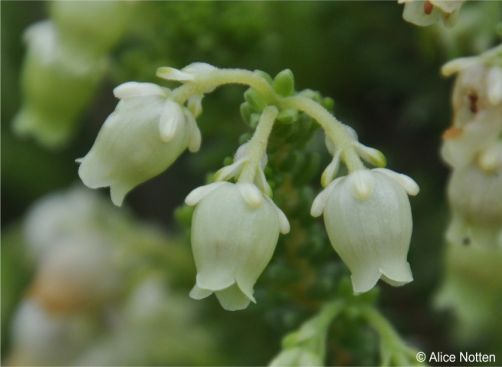
Description
Description
The plant forms a spreading to erect plant up to ±1 m high. The unusually thick and short leaves are very conspicuous compared to the thin, needle-like leaves of most ericas. The greenish-yellow flowers are terminal, 4-nate, borne in umbels, and have a notably sticky feel when touched. The 8 mm long corolla has an oblong urn shape. The anthers are aristate, which means they have horn-like appendages. Flowering time is from late summer into winter (January to July).
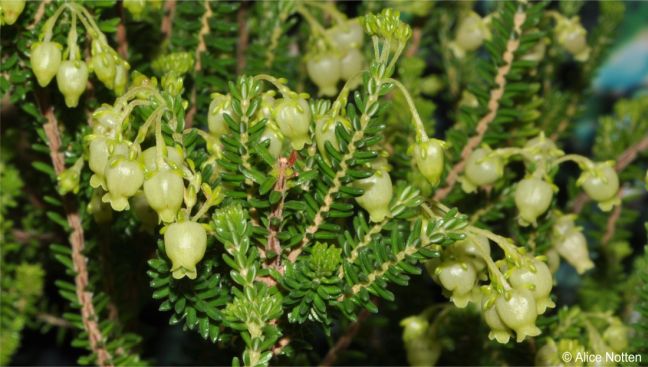
Conservation Status
Status
According to the SANBI Red List of South African plants, Erica oblongiflora was assessed as Critically Endangered (CR) in 2009 and is currently assessed as Endangered (EN). It is a Rare species that has only been observed in 3 locations. Threats to the survival of this plant include alien plant invasion, livestock grazing and brush-cutting activities.

Distribution and habitat
Distribution description
Erica oblongiflora is endemic to South Africa and has a Western Cape distribution. The species is restricted to limestone soil types and stable dune areas on the Agulhas Plain. Its habitat is highly threatened.
Derivation of name and historical aspects
History
The genus name Erica derives from the Latin word ereiko which means ‘heath’ or ‘broom’. The specific epithet also derives from a Latin word, namely oblongus which means ‘oblong’ and refers to the shape of the corolla.
The genus Erica comprises ±800 species, of which ±700 species are indigenous to South Africa, and 600 of these species are found in the Cape Floristic Kingdom alone.

Ecology
Ecology
Erica oblongiflora has been observed being visited by sunbirds and by insects. The flowers of the plant are oblong and small and not usually a sunbird’s favourite flower shape, they more commonly visit ericas with tubular flowers. These visitors to the plant benefit from nectar from the flower and also play a role in its pollination, they contribute to the pollination process by visiting different flowers.
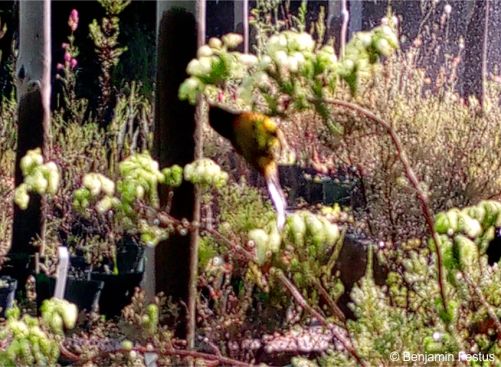
Some ericas have developed features such as wax-like, hairy or extremely sticky flowers which may serve as a protection feature for the plant. The shape of the flowers may also determine which pollinators come and visit their flowers. It is interesting to notice that ericas present virtually all flower colours and various combinations except for blue.
The seeds of Erica species are usually very tiny and can lay dormant in their natural habitat for years and will germinate when the conditions become favourable, such as when ample moisture levels in the soil and ideal day and night temperature arise. Various animals depend on erica plants as a food source.
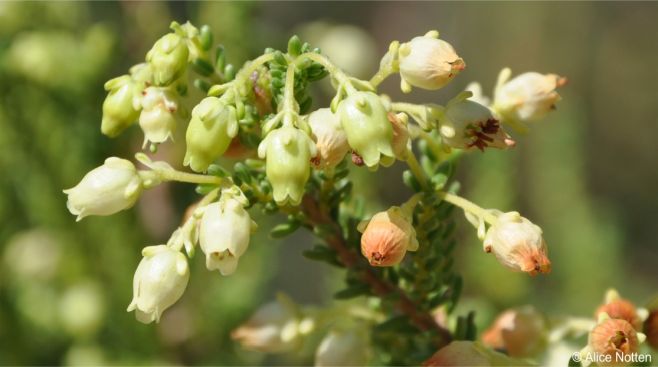
Uses
Use
Erica oblongiflora can be successfully used as part of a garden plant bed display amongst a variety of fynbos plants including restios. It also makes a good pot plant as long as good drainage is provided.
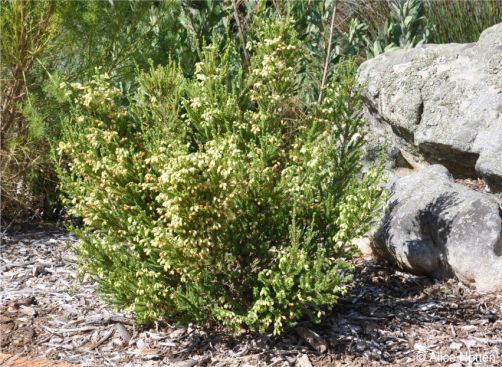
Growing Erica oblongiflora
Grow
Erica oblongiflora grows naturally in limestone soil but can easily adapt to growing in soil with a pH ranging from 5.5-6.7, it also grows well in a full sun position.
It is worth noting that ericas that naturally grow in acidic soil will not tolerate being planted in limestone soil, however those that grow in alkaline soil will tolerate acidic soils, a phenomenon that is not yet well understood. This plant needs soil with good drainage especially when planted in pots. The plant may be pruned after flowering to encourage new growth and to generally clean up the plant by removing dead or damaged wood. Matured compost can be used when planting directly into the ground, organic fertilisers may be added in very low concentrations, but ericas do not respond well to chemical fertilisers. Organic liquid fertiliser is ideal for potted plants.
Erica oblongiflora can be successfully propagated by taking ±40-50 mm long cuttings, ideally two months after flowering, as a general rule for propagating ericas. Use a rooting medium of fine-milled bark and perlite balls at a 50:50 ratio to improve the chances of successful rooting. Propagation of this plant by cuttings is a much easier approach, seed sowing is a longer process because seeds need to be treated for example soaking it in a ‘fynbos smoke liquid’ (an extract from fynbos plants) before sowing.
Transplant rooted cuttings into small pots, once the root system has well developed it can be transplanted into half-litre plastic bags, use a mixture of 7 parts milled bark and 3 parts sand, and harden the cuttings off for a month before placing in open environmental conditions where it will receive full sun. The rooted cuttings respond best to an organic liquid fertiliser applied every two weeks. The cuttings will be ready for planting after about 3 months.
Use equal parts of river sand and sifted composted bark as a sowing medium, and 100 mm deep seed trays are ideal to hold the mix. Prevent sowing seeds too densely by mixing them with fine river sand when broadcasting. Water carefully with a fine hose to prevent seeds from being washed from the tray, and shade the seeds lightly.
The application of an organic or systemic pesticide can be used to control pests like mealybug, red spider mites and scale insects commonly found on this plant. Root rot can be prevented in plant beds or pots by planting in soil or a potting mix with good drainage. Do not sow seeds too densely and ensure good air circulation in the propagation unit to prevent fungal attacks on the young plants.
References
- Euston-Brown, D. 2005-02. Observation of Erica oblongiflora, Heuningberg, Agulhas Plain. iNaturalist. Online. https://www.inaturalist.org/observations/10976879.
- Goldblatt, P. & Manning, J. 2000. Cape Plants. A conspectus of the Cape flora of South Africa. Strelitzia 9. National Botanical Institute, Pretoria & Missouri Botanical Garden, Missouri.
- Helme, N.A. & Trinder-Smith, T.H. 2006. The endemic flora of the Cape Peninsula, South Africa. South African Journal of Botany 72(2): 205–210.
- Raimondo, D., Von Staden, L., Foden, W., Victor, J.E., Helme, N.A., Turner, R.C., Kamundi, D.A. & Manyama, P.A. (eds) 2009. Red list of South African plants. Strelitzia 25. South African National Biodiversity Institute, Pretoria.
- Schumann, D., Kirsten, G. & Oliver, E.G.H. 1992. Ericas of South Africa. Fernwood Press, Vlaeberg.
- Oliver, E.G.H., Turner, R.C. & Raimondo, D. 2011. Erica oblongiflora Benth. National Assessment: Red List of South African Plants version. Accessed on 2024/06/02.
Credits
Benjamin Festus
Kirstenbosch National Botanical Garden
July 2024
Acknowledgements: the author thanks Alice Notten and Douglas Euston-Brown for images.
Plant Attributes:
Plant Type: Shrub
SA Distribution: Western Cape
Soil type: Sandy, Loam
Flowering season: Late Summer, Autumn, Winter
PH: Acid, Alkaline, Neutral
Flower colour: Green, Cream, Yellow
Aspect: Full Sun
Gardening skill: Average
Special Features:
Horticultural zones







Rate this article
Article well written and informative
Rate this plant
Is this an interesting plant?
Login to add your Comment
Back to topNot registered yet? Click here to register.